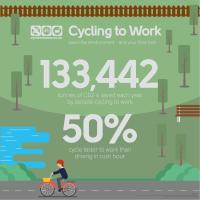Cycling to work makes employees happier, healthier and more productive. But they can’t do it without the right kit. Cycling UK's digital officer Rebecca Armstrong explains how employers can make the most of the Cycle to Work scheme
The Cycle to Work scheme is a government initiative that allows employees to obtain a new cycle, along with necessary equipment, via their employer. It works as a salary sacrifice benefit which means employees can make tax and National Insurance savings on the cost of a new bike.
Essentially, employees rent a new cycle and safety kit through their salaries, with the option to buy it at the end of the salary sacrifice period, which is usually 12 months. You, as the employer, pay for the equipment up front and then recover the cost through monthly payments. As payment is taken from employees’ gross salaries, they pay less tax and National Insurance. For more detailed information about the scheme, read our comprehensive guide.
What employees get out of the scheme is clear: a new bike and kit at a reduced price, no upfront payment, no interest, and the cost spread over 12 or more months. They also save money long term on travel costs. But what’s in it for you?
Firstly, it won’t cost you anything. The scheme is free to join and while you do have to cover initial payments for employees’ bikes, you claim that back in full via their salary sacrifice.
In fact it will save you money. Employers can save up to 13.8% on National Insurance contributions for every employee who uses the scheme – an average saving of £138 on every £1,000 you process via the programme.
You’ll also benefit from a happier, healthier and more productive workforce. Active travel, such as cycling or walking to work, improves physical fitness as well as wellbeing. It also reduces absenteeism – on average people who cycle to work regularly take 1.3 fewer sick days per year than those who don’t.
It also helps to reduce your company’s environmental impact, as well as that of your staff members. This is something that it is of increasing importance among potential employees, especially younger ones. It helps in fulfilling your corporate social responsibility, as employees reduce their carbon footprint.

Essentially you choose which of the providers best matches your needs and sign up. It really is that easy. There are several providers, all of which offer slightly different schemes. Which scheme you sign up to will dictate things like which brands or retailers you can use, so it’s worth doing a bit of research before you choose; a list of the main providers is given below.
Consult with staff on what sort of cycles and kit they might need. The scheme itself doesn’t place any limits on what sort of bike employees can get – it just has to be suitable for getting them to work. The government previously capped the total spend on cycle and equipment at £1,000, but this has now been lifted, with no upper limit in place at all.
But individual providers might have their own conditions in place. In order to be as inclusive as possible, it might be that you need to offer folding bikes, e-cycles or adaptive cycles. Check before signing up to a scheme that these models are all available through it.
Once you’ve chosen your scheme, it’s usually just a case of filling in an online form with company details and nominating a point of contact. You’ll be issued with a unique code that you pass on to employees when they choose their kit.
The schemes generally offer support with admin as well as promotional materials and activities to raise awareness of the benefit to your workforce.
Employees can now choose their bike and accessories; they submit this to you for approval. The order then goes to the scheme provider, which will issue the employee with a code or certificate to purchase the package. When it’s been delivered, you’ll be issued with an invoice. You’ll have to set up the salary sacrifice via payroll in order to start recovering the cost.
The scheme is only open to employees who pay tax on a PAYE (Pay As You Earn) basis. If you employ a lot of staff on a freelance basis, they won’t qualify.
This is a hire scheme so your employees won’t own the kit at the end of the agreement. Instead they have the option to buy it at a reduced cost, return it or extend the hire period, at the end of which they will own it.
One drawback of the scheme is that the salary sacrifice arrangement mustn’t take an employee’s take-home earnings below the National Minimum Wage. This is particularly relevant to anyone requiring an e-cycle or adaptive cycle, which can run to several thousand pounds. One way round this is to extend the hire period to reduce the monthly payments.
The Cycle to Work Alliance – a coalition of five of the biggest scheme providers – is calling on the government to introduce an exemption Cycle to Work scheme from the National Minimum Wage regulations. It is also asking for the Cycle to Work scheme to be included as a permissible expense under travel costs for self-employed workers, just as train tickets and fuel are currently.
There are several providers that employers can register with. The main ones are:
Cyclescheme, Cycle Solutions, Evans Cycles, Halfords and Vivup together form the Cycle to Work Alliance.